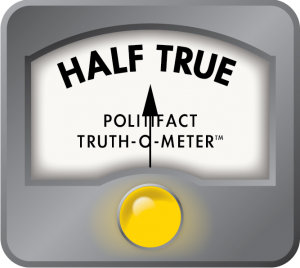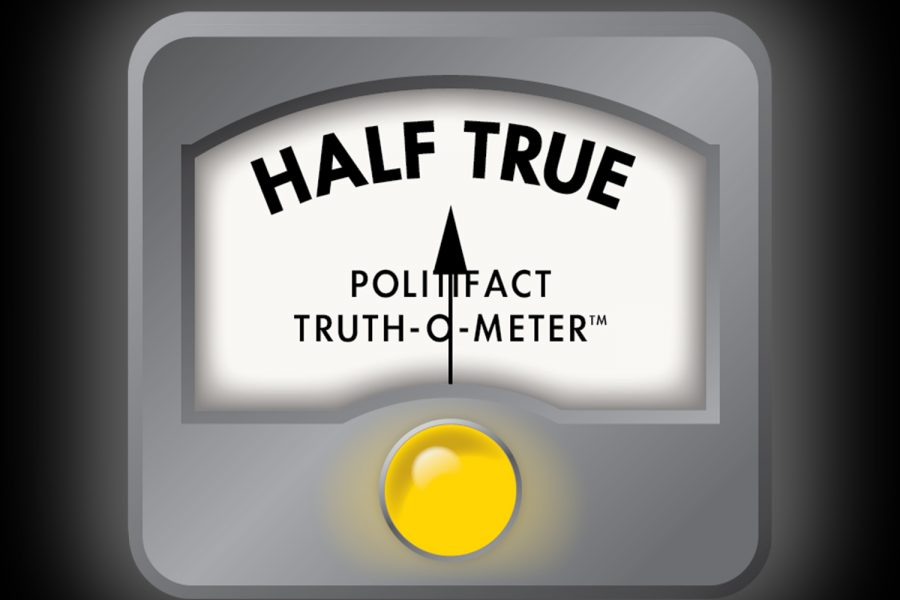Fact Check | Sanders claim that childhood poverty is cut in half needs a little more time to confirm
Sen. Bernie Sanders I-Vt. said childhood poverty in the U.S. was cut in half thanks to a child tax credit in the American Rescue Plan. Until 2021 numbers are established, though, only projections exist.
September 14, 2021
PolitiFact Iowa is a project of The Daily Iowan’s Ethics & Politics Initiative and PolitiFact to help you find the truth in politics.
If you’re time is short
- Sen. Bernie Sanders, I-Vt., said in Iowa visits that U.S. childhood poverty was cut in half thanks to The American Rescue Plan’s increased child tax credit.
- The credit was increased to $3,600 a year, or $300 a month for families with children.
- According to the U.S. Census Bureau, 14.4 percent of children lived in poverty in 2019 and 16.1 percent in 2020. While multiple researchers say childhood poverty will fall below 6 percent for the year, numbers for 2021 have not been released yet.
Sen. Bernie Sanders I-Vt., said on an August tour to Republican-led states where he pitched the Senate’s $3.5 trillion budget plan that the American Rescue Plan cut U.S. childhood poverty in half.
One of the stops where he said this was in Cedar Rapids, Iowa, on Sunday, Aug. 29.
On Feb. 23, before the American Rescue Plan was enacted, President Biden made the same claim, saying the plan’s increased child tax credit would cut childhood poverty in half if the law passed. He, since, has repeated the assertion.
The American Rescue Plan increased the Child Tax Credit from $2,000 to $3,200 and $3,600 for children under six, or $300 a month. The plan also made more people eligible for the credit which increased the total granted to $4,000 for one qualifying individual and $8,000 total for two or more.
Biden’s assertions, repeated by Sanders, are true in one regard: the projected poverty rate for 2021 would cut the rate by more than one-half. But we haven’t been through the year to see whether or not the projection will be true.
A U.S. Census Bureau report released Sept. 14 showed the poverty rate for Americans under the age of 18 and younger was 16.1 percent in 2020. That is up from the Census Bureau report of 14.4 percent in poverty in 2019 but lower than any rate before 2019 since 16 percent in 1976.
In-depth reporting for the plan previously done by PolitiFact showed that the prediction was made using a poverty reduction analysis report by Columbia University on Jan. 14, 2021.
The Columbia report predicted that the number of people under the age of 18 living in poverty would decrease 51.1 percent because of several proposed policy elements including the expanded Child Tax Credit. The analysis did not account for other policy elements that would impact policy rates like an increased minimum wage, child care assistance and rental assistance.
According to a July 28 report from The Urban Institute, a nonprofit research organization, the projected poverty rate for children in 2021 is 5.6%. Additionally, the report said that federal stimulus checks in general have a larger antipoverty impact than unemployment insurance or means-based benefits.
“If all other programs were in place but the stimulus checks had not been paid, we project 12.4 million more people would be in poverty in 2021,” the report said.
During the week of March 14, 2020, the number of Iowa families who requested food and financial assistance increased by over 1,000 to 4,672. The same relative week a year before, 3,173 had sought the assistance. By the week of April 4, 2020, 7,342 families had requested assistance.
Alex Carfrae, Iowa Department of Human Services’ public information officer, said that, while the American Rescue Plan is providing direct financial relief to Iowa families, it is too early to know whether or not child poverty in Iowa has dropped since the plan became law.
In 2019, 12.8% of children in Iowa were experiencing poverty, That was down from 13.5% from the previous year.
Carfrae said the Department of Human Services does not keep track of poverty numbers in the state but rather through program utilization.
“Many of the assistance programs that the DHS administers saw dramatic shifts in utilization as a result of the COVID-19 pandemic, making any analysis based on DHS programs or enrollment data challenging,” Carfrae said.

Our ruling
Sanders was specific in his Cedar Rapids statement, that the $300 monthly payment working parents receive has reduced U.S. childhood poverty 50%. He stated that as fact, not a projection.
Researchers from Columbia University and the Urban Institute project that childhood poverty in the U.S. will fall this year by more than one half, from 16.1% in 2020. However, this is just a projection; more than three months remain in 2021, and it will take additional time for official data to be released.
Because this drop is expected by credible research but hasn’t happened yet, we rate the statement Half True.
Sources
The Urban Institute, “2021 Poverty Projections: Assessing the Impact of Benefits and Stimulus Measures,” Jul. 28, 2021.
PolitiFact Iowa Interview with Alex Carfrae, Iowa Department of Human Services, Sept. 2, 2021
The White House, “The Child Tax Credit,” briefing document.
The White House, “Remarks by President Biden in Roundtable with Black Essential Workers Moderated by Domestic Policy Advisor Susan Rice,” Feb. 23, 2021.
Politifact, “Joe Biden’s plan to cut child poverty by half: What you need to know”, Feb. 25, 2021.
Columbia University Center on Poverty and Social Policy, “The Potential Poverty Reduction Effect of President-Elect Biden’s Economic Relief Proposal,” Jan. 14, 2021.
The Daily Iowan, “Sen. Bernie Sanders in Cedar Rapids to pitch $3.5 trillion budget to Iowans,” Aug. 29. 2021.
Iowa Department of Human Services, “COVID-19 Weekly Dashboard,” April 30, 2020.
Iowa State Data Center, “Estimated number and percent of people in poverty by age,” Feb. 15, 2021.
Reuters, “Biden sees U.S. child tax credit as ‘giant step’ to counter poverty,” July 15, 2021.
U.S. Census Bureau, “Poverty Status of People by Age, Race, and Hispanic Origin,” released September 2021.



